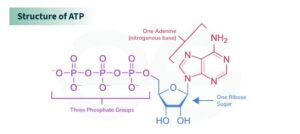
ATP consists of an adenine base, a ribose sugar, and three phosphate groups. The structure can be represented as follows:
Related Questions:
- Why are enzymes called biological catalysts?
- Name the factors affecting enzyme activity. At what pH do pepsin and trypsin enzymes act the best?
- What happens to an enzyme when it is frozen below 0°C?
- What happens when a protein-digesting enzyme functions in an acidic medium?
- How does an enzyme lower the activation energy?
- Why are enzymes specific and why can’t each one speed up many different reactions?
- Why is a small quantity of enzyme enough for catalyzing a large number of substrate molecules into products?
- According to the induced fit model, the active site is flexible. Does it mean that any substrate can attach to this flexible active site? If not, then explain.
- The science of Biology
- Define the following branches of biology and give at least one significance of studying these branches.
- Can you distinguish between:
- Healthy life of a person depends on healthy life choices. How does the study of biology help in maintaining a healthy life?
- What is the contribution of the following scientists?
- Observations are mainly of two types, qualitative and quantitative. Sort the following observations accordingly:
- A Nobel Prize winner gave a hypothesis about the effects of the COVID-19 vaccine. Can it be wrong? Why? Develop a deduction from the hypothesis, “Vaccination of COVID-19 can reduce the severity of complications in case of infection.”
- Why is it impossible to eradicate malaria?
- The diagram shows one insect. Answer the following questions related to it.
- Why did Ross not allow infected mosquitoes to bite a healthy person?
- Hepatitis B virus was found in the blood of 10 persons, but only 6 of them were suffering from the disease. Why?
- How is biology related to other sciences? Show and explain the link.